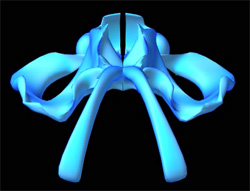UMR researchers expand website to dissect frogs
Posted by news
Dissecting frogs online is an everyday experience for two researchers at the University of Missouri-Rolla.
Biologist Dr. Anne Maglia and computer scientist Dr. Jennifer Leopold are the creators of MorphologyNet, a web-based library of 3-D reconstructions of animal anatomy. Currently the site houses images of frogs only, which is Maglia’s specialty. But by May 1 of next year, the site will include images of turtles, humans, salamanders, birds and fish. This expansion is made possible by a three-year grant from the National Science Foundation totaling more than $660,000.
 |
| Chondrocranium of Pelobates cultripes (frog), Gosner stage 37 (tadpole) by Paul Hogrebe, a chemical engineering student at UMR |
“We were really lucky to get funding for this project,” says Maglia, assistant professor of biological sciences. “I believe this is the new paradigm for anatomical research, and it is exciting to be on the forefront of developing tools and to lead the way in the advancement of a field of study.”
MorphologyNet allows researchers and educators to study tiny organisms, such as frogs the size of a quarter. Researchers can easily compare two organisms by studying their digital reconstructions, as opposed to using a microscope to study animal parts. However, Maglia also uses the site to investigate why amphibian populations are on the decline, as well as possible connections between frog malformations and degenerating environmental conditions. Studying digital images reduces the number of endangered species used for research.
“One thing that is really important is the ability for us as researchers to share images worldwide with colleagues and the public,” Maglia says. “This elevates our level of science and collaboration, and it allows us to see similarities between organisms that may not necessarily be closely related. It opens up huge doors for collaboration and integration of research programs.”
With MorphologyNet, contrary to other anatomical digital libraries, not just one group is making all the images. Instead, it is a community resource that has software compatible with almost any computer. “People can still own their own images,” Maglia says. She compared the site with GenBank, a worldwide database of DNA sequences.
The prototype for MorphologyNet was created about a year ago. However, Maglia has been dreaming about this idea for years. She applied for NSF funding for this project during her post-doctoral studies at the University of Kansas, but she did not receive the funding at that time.
“You may have a great idea,” Maglia says, “but it must prove doable.” Maglia and Leopold , assistant professor of computer science, proved that the idea is in fact doable when MorphologyNet went online last year. “This is something we put our heart and soul into for several years, so to get it funded made me pretty happy,” Maglia says.
The NSF grant will fund research through the end of August 2008. Maglia says one of the goals for the grant includes increasing the number of images in the digital library. Her plan includes doing more digital reconstructions at UMR as well as encouraging more contributions from researchers worldwide. Maglia has also hired a post-doctoral researcher to work full-time on the project by studying the anatomy and development of amphibians.
Another goal includes improving the computer software on the site to make MorphologyNet more user-friendly, which is a specialty of co-investigator Leopold. In addition, the next version will have a new interface, measurement tools and a search engine. Maglia says it will also load faster.
“This will encourage more researchers and educators to use the site,” Maglia says. “It also allows users to be able to study realistic anatomy, but with the addition of viewpoints and tools they wouldn’t have otherwise.”